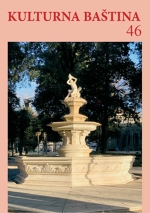SPLITSKE ZASTAVE (1) – ZASTAVE GRADA SPLITA
THE FLAGS OF THE CITY OF SPLIT
Author(s): Željko HeimerSubject(s): Maps / Cartography, Public Administration, Local History / Microhistory, Modern Age, Recent History (1900 till today)
Published by: DRUŠTVO PRIJATELJA KULTURNE BAŠTINE - SPLIT
Keywords: flag; vexillology; coat of arms; heraldry; municipal identity symbol; municipal flag; city flag;
Summary/Abstract: Since time immemorial, the corner stone of the city of Split’s visual identity has been the monumental Diocletian’s Palace with St. Domnius’ cathedral belltower. This is a recurring motif on coats or arms and signets since the 14th century. Historical sources on the use of flags are of a newer date, although 16th century portulan nautical charts occasionaly depict flags above the port of Split – showing variations of the Bribir dukes’ coat of arms. The municipal flagpole in Split, the so-called štandarac, also dates from the same time. We know it has been located on the present-day People’s Square in Split since 1515. It was never clear which flag was displayed on this flagpole, but we can assume it must have been that of the Venetian Republic. A special flag with the symbols of Split is depicted in one of Antonio Zuedenigo’s 18th century watercolor paintings: a blue flag with white decorations, displayed on the balcony of the municipal theatre building on the present-day People’s Square. At the end of the 19th century, after the victory of the Croatian national party in the municipal government a tricolor red, white, and blue flag was introduced into use. This flag was based on the then modernized coat of arms, which was also formally assigned to the city of Split in 1887. The use of the tricolor Croatian flag, with the city’s coat of arms in the middle, as the formal city flag, was also adopted by other Dalmatian municipalities at the time, as a way of displaying a Croatian flag in the then administratively separate Kingdom of Dalmatia. In the aftermath of the Dictatorship of January 6, the use of all local symbols was forbidden, including flags, and after WWII the new regime at first refrained from the use of the ideologically ‘suspicious’ local symbols. A new municipal coat of arms was adopted in 1969, with a historical Croatian coat of arms and a coat of arms with a five-point red star on both sides of the belltower. Use of flags was recorded even earlier, in the 1960s, for certain public ceremonies, such as the Theatre Summer in Split. These flags were blue with white symbols. A blue flag with a white symbol was also adopted as the official flag of the Mediterranean Games held in Split in 1979, which remained in use as the official city flag for the following decade, when it became replaced with a flag marking the 1700-year anniversary of the foundation of the city of Split. This latest flag also remained in the practical function as the city flag for the following decade. The third version of the city flag, based on the visual identity of the previous one, was finally adopted as the official city flag. Both these flags, as well as the one designed for the Mediterranean Games, were authored by the renowned Croatian designer Boris Ljubičić. The latest city flag’s background features different shades of blue. On top of this blue-shaded background is a stylized white logo consisting of the name of Split, which is repeated and stacked together so it forms the Palace with the belltower. Both the flag and the modified 1991 version of the coat of arms in which St. Domnius replaced the red star, do not meet the requirements of the heraldic and vexillological principles prescribed for coats of arms and the flags of local governments, and are not approved by the Croatian Ministry of Public Administration.
Journal: KULTURNA BAŠTINA : ČASOPIS ZA PITANJA PROŠLOSTI SPLITSKOGA PODRUČJA
- Issue Year: 2020
- Issue No: 46
- Page Range: 25-68
- Page Count: 44
- Language: Croatian

